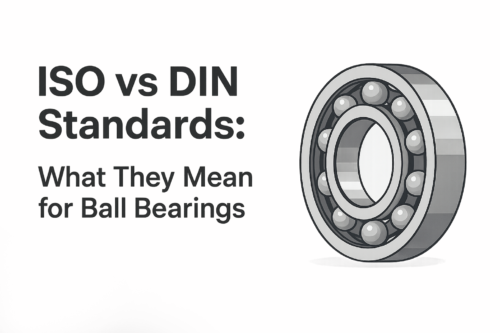Understanding ISO and DIN: Why These Standards Still Matter
When it comes to sourcing precision components like ball bearings, quality isn’t just about material and manufacturing — it’s about meeting the right standards. Two of the most referenced are ISO and DIN.
At STR Industries, we work with both and help our customers understand which standards apply to their specific needs.
What Is ISO?
ISO (International Organization for Standardization) is a global body that creates and publishes standards across nearly every industry — from quality management (ISO 9001) to environmental protection (ISO 14001), and yes, even ball bearings.
- 🌍 International in scope
- 🤝 Developed by global consensus
- ✅ Used by manufacturers, governments, and industries worldwide
- 🛠️ Examples: ISO 3290 (precision balls), ISO 9001 (quality management)
In ball bearing manufacturing, ISO ensures a consistent level of tolerance, roundness, surface finish, and material quality — regardless of where in the world the part is produced.
What Is DIN?
DIN (Deutsches Institut für Normung) is the German Institute for Standardization. While DIN standards are national, many are deeply respected in mechanical engineering, manufacturing, and quality control.
- 🇩🇪 Developed in Germany
- 🧪 Known for technical depth and precision
- 🌍 Influential in Europe and sometimes globally
- 🛠️ Examples: DIN 5401 (precision steel balls), DIN 476 (paper sizes), DIN EN 10027 (steel naming)
DIN 5401, for example, outlines tolerances, grades, and roundness levels for precision balls used in bearing applications — and often overlaps or aligns with ISO 3290.
ISO vs DIN: Key Differences
| Feature | ISO Standards | DIN Standards |
|---|---|---|
| Scope | International | Primarily German (with global influence) |
| Developer | International Organization for Standardization | Deutsches Institut für Normung |
| Use Case | Global consistency across industries | Technical precision for German and EU markets |
| Examples (Bearings) | ISO 3290 (ball tolerances) | DIN 5401 (ball tolerances) |
| Adoption | Widely used in global sourcing and trade | Often harmonized with ISO in engineering |
Why These Standards Matter for You
If you’re building or maintaining machinery, sourcing internationally, or trying to reduce risk in your supply chain — these standards help ensure:
- ✅ The ball bearings you receive match exact size and grade specs
- ✅ There’s interoperability across components, even when sourced from multiple countries
- ✅ You can compare options fairly across different suppliers
In short, standards like ISO and DIN remove the guesswork.
How STR Industries Applies These Standards
At STR Industries, we source and supply precision balls that meet or exceed ISO 3290 and DIN 5401 specifications. Our clients come to us when:
- They need tight tolerances and reliable sizing
- Their applications require high-speed, low-friction performance
- They’re unsure which spec to use — and want expert guidance
We also provide material certifications, dimensional reporting, and custom sourcing options to match your spec sheets and engineering requirements.
Which Standard Should You Follow?
- If you’re sourcing globally or working across borders, ISO is often your reference point.
- If you’re dealing with German machinery, technical drawings from Europe, or applications requiring high-precision steel balls, DIN may be the base spec.
In many cases, both align, and we can walk you through how to match the correct grade and material.
🔧 Final Word
It’s 2025, and quality expectations are higher than ever. Whether your bearings go into wind turbines, medical devices, or robotics, getting the standard right can make or break your product’s performance.
That’s why standards like ISO 3290 and DIN 5401 aren’t just paperwork — they’re the backbone of precision engineering.
📞 Talk to a Standards-Savvy Supplier
If you need help sourcing ISO- or DIN-compliant ball bearings, or want guidance on choosing the right material or grade, we’re here to help.
👉 Contact STR Industries to request a quote or speak with a technical specialist.


